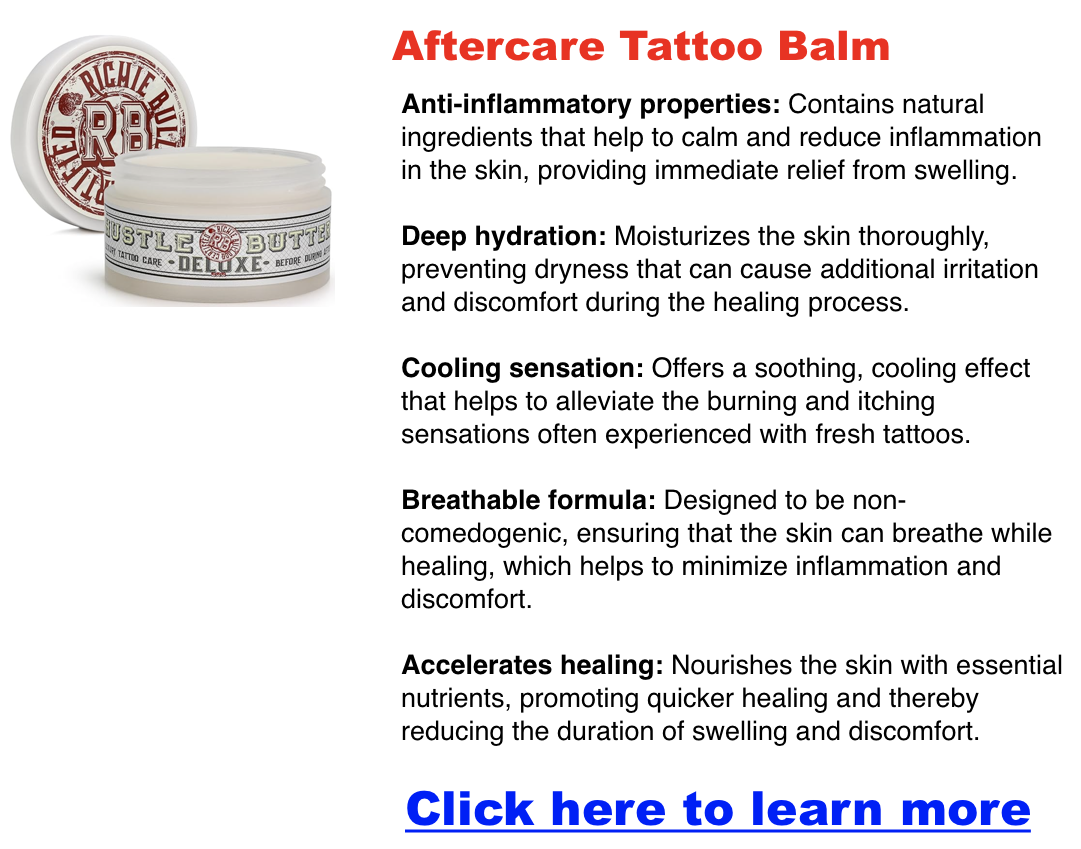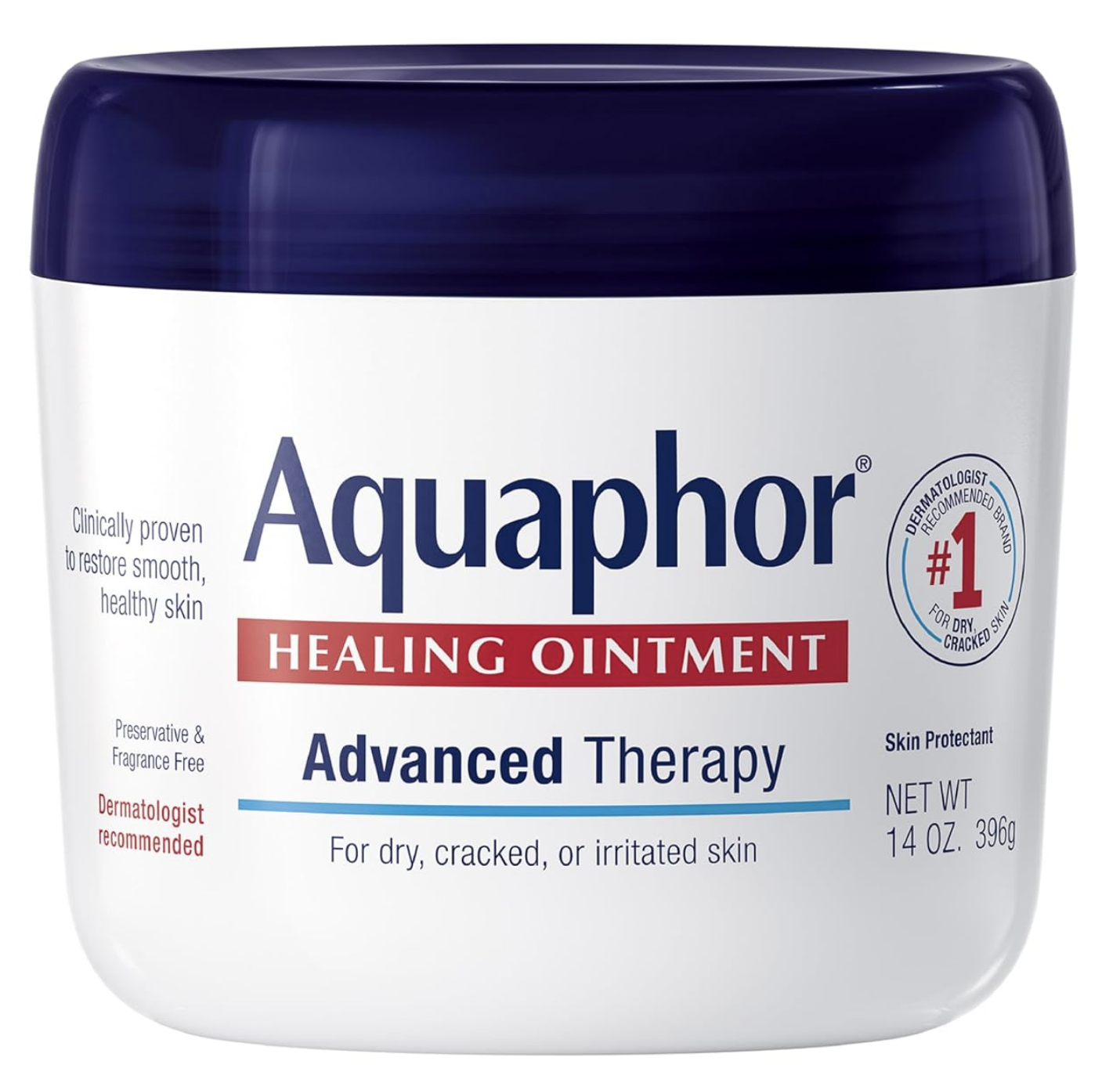Tattoo Aftercare: How to Reduce Tattoo Swelling & Discomfort
Getting a new tattoo is an exciting experience. Still, it’s just the beginning because you must ensure your new artwork heals correctly and lasts a lifetime by managing swelling after getting a tattoo and properly caring for it during the healing process. Swelling is a natural response to the tattooing process, but how you handle it can significantly impact the outcome of your tattoo.
This guide provides comprehensive insights into the best practices for tattoo aftercare, specifically focusing on reducing and managing swelling. Whether you’re getting your first tattoo or a seasoned enthusiast, understanding the nuances of tattoo healing can make all the difference. From choosing the right aftercare methods to knowing how long swelling should last, we’ll cover everything you need to know to ensure your tattoo heals perfectly and remains vibrant for years.
How Long Does Tattoo Swelling Last?
Click here for my favorite way to reduce swelling & discomfort
The duration of swelling varies depending on the tattoo’s location and size:
- General Estimate: Typically, swelling lasts for 24-48 hours.
- Swelling After Tattoo on Arm: Can last up to a week, especially near joints or in movable areas.
- Leg Swelling After Tattoo: Might be more severe and last longer than in other areas.
- Large Tattoos: Tend to have prolonged swelling.
Tattoo Healing and Swelling Reduction Steps
- Immediately Ice the Tattoo: This can significantly reduce initial swelling.
- Follow a Healing Guide: Adhering to a structured care plan will help manage swelling and promote healing.
- Use Gentle Cleaning Products: Avoid harsh chemicals or scented products that could irritate the skin and increase swelling.
Tattoo Aftercare Products for Swelling Management
Consider using gentle, antimicrobial tattoo towels to clean the tattoo. These can help manage swelling and keep the area sterile. Additionally, following a week-by-week healing guide can provide specific tips and steps for each stage of the healing process.
Ointment Application and Air Exposure
To reduce swelling and promote healing, using a healing ointment and allowing the tattooed area to breathe will help. Apply a layer of ointment to keep the skin hydrated without suffocating it. This method is particularly effective for areas less prone to friction and can be easily cleaned, and reapplied as needed.
- Choosing the Right Ointment: Opt for an ointment specifically designed for tattoo aftercare. Look for products that are fragrance-free and contain ingredients known for their healing properties, like aloe vera or vitamin E.
- Application Technique: After cleaning your tattoo, apply a thin layer of ointment. The key is moderation; too much can clog pores and too little might not provide sufficient moisture. Your tattoo should not look or feel overly greasy.
- Frequency of Application: Initially, you might need to apply the ointment several times a day. As your tattoo starts to heal and the skin becomes less tender, you can reduce the frequency of application.
Plastic Wrap Protection
This approach involves covering the tattoo with plastic wrap. It’s especially beneficial immediately after getting the tattoo and for areas more likely to come into contact with clothing or other irritants. The wrap helps to protect the tattoo from irritation that can exacerbate swelling and should be changed regularly to maintain hygiene.
- Initial Wrapping: Your tattoo artist will typically cover your new tattoo with plastic wrap immediately after the session. This initial cover is meant to protect the tattoo from airborne bacteria and any potential friction from clothing.
- Duration of Use: Keep the wrap on for the first few hours post-tattooing. The exact time depends on the size and location of your tattoo, as well as your artist’s recommendations.
Changing the Plastic Wrap
- Frequency of Change: If your tattoo artist advises you to keep using plastic wrap for a day or two, ensure you change the wrap at least 2-3 times a day. It’s important to clean the tattoo and apply fresh ointment each time you change the wrap.
- Hygiene: Always wash hands thoroughly before handling the wrap or touching your tattoo. Use a clean, disposable wrap each time to avoid contamination.
Balancing Protection and Healing
- Avoid Overuse: Prolonged use of plastic wrap can create a moist environment that’s conducive to bacteria growth. Use the wrap only as long as recommended by your tattoo artist.
- Monitoring the Skin: Pay attention to how your skin reacts under the wrap. If you notice excessive redness, itching, or any signs of a rash, it might be a reaction to the wrap, and you should stop using it.
Aquaphor Healing Ointment
Common Healing Stages and Managing Swelling
During the healing process, it’s normal to experience peeling, flaking, shiny skin, and itching. This is particularly pronounced in areas like the arms. Resist the urge to disturb the skin by scratching or picking at it, as this can increase swelling and even lead to infection.
Observe for signs of infection and moisture rash, as these can significantly increase swelling. Additionally, scabbing and color loss are potential risks if swelling is not properly managed. Keeping the tattoo clean and dry is necessary, as is avoiding prolonged exposure to water and sunlight, which can exacerbate swelling.
Don’t hesitate to contact the tattoo studio if you notice unusual swelling or other concerning symptoms. They can provide guidance specific to your ink. Additionally, many studios offer touch-up services if swelling affects the tattoo’s appearance, typically within a few months after the initial session, so now is a good time to ask about the option.
Steps to Reduce Tattoo Swelling and Enhance Healing
To manage swelling effectively:
- Gently Wash the Tattoo: Use mild soap and lukewarm water. Pat dry with a clean cloth.
- Apply Lotion or Ointment: Choose products specifically designed for tattoo aftercare (we’ve got a great article on the best lotion for your tattoo here)
- Rest, Ice, and Elevate: Especially important for “leg swelling after tattoo.” This reduces blood flow to the area, decreasing swelling.
- Avoid Sun and Water: Protect your tattoo from prolonged sun exposure and wear sunscreen (we’ve got an article on tattoo sunscreen) avoid submerging it in water.
- Monitor for Infection: If you observe excessive redness, heat, or pus, seek medical advice.
- Birth Flowers Chart by Month
- Aurora Borealis Tattoo
- How Printable Tattoo Stencils Work (and How to Make Your Own from Any Design)
- Arm Swollen After a Tattoo? What You Need to Know
- Tattoo Aftercare: How to Reduce Tattoo Swelling & Discomfort
- Tattoo Aftercare Products & How They Fit Into Caring for Your Tattoo
- How To Brighten a Tattoo
- American Traditional Tattoo Style
- Best Tattoo Lotions For New or Old Tattoos
- This Too Shall Pass Tattoo
- Flowers (7)
- Halloween (5)
- Uncategorized (93)


